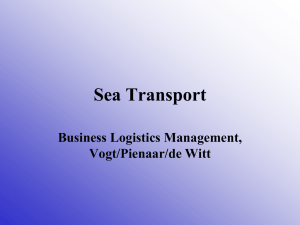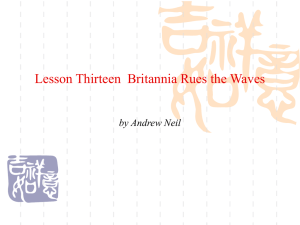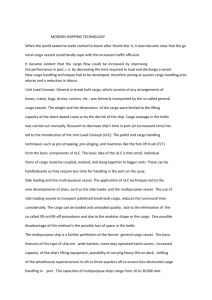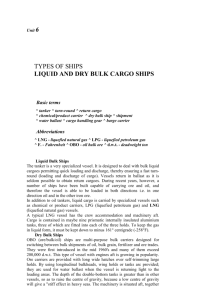ferrous and non-ferrous metals
advertisement
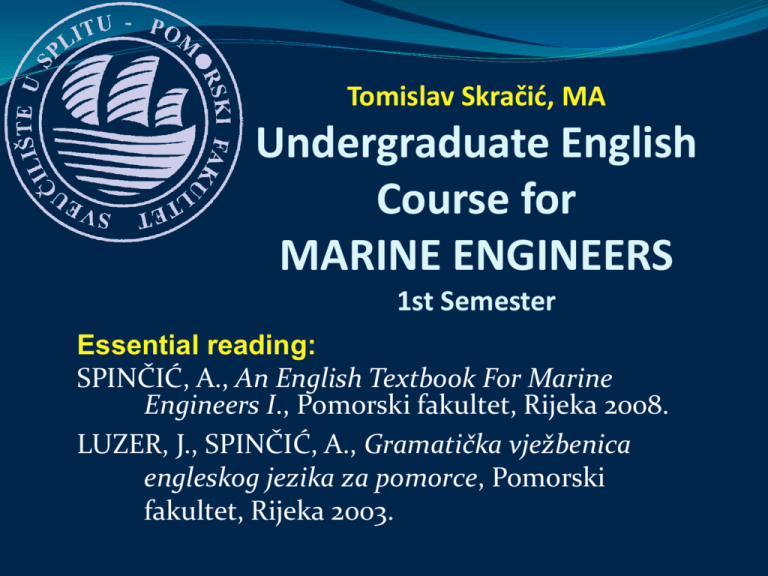
Tomislav Skračić, MA Undergraduate English Course for MARINE ENGINEERS 1st Semester Essential reading: SPINČIĆ, A., An English Textbook For Marine Engineers I., Pomorski fakultet, Rijeka 2008. LUZER, J., SPINČIĆ, A., Gramatička vježbenica engleskog jezika za pomorce, Pomorski fakultet, Rijeka 2003. Types of vessels – 4 GENERAL CARGO SHIP CONTAINER SHIPS CRUISE SHIPS BULK CARRIER MULTIPURPOSE SHIP HEAVY-LIFT SHIPS SPECIAL-PURPOSE VESSELS General cargo ship The cargo holds on these ships carry almost any kind of cargo, both piece goods and bulk cargo. The cargo is packed into drums, boxes, bags, bales and crates or on pallets. The ship is loaded and unloaded using portside cranes and ship’s derricks that lift the cargo through the hatches and store it into the holds. A general cargo ship has several large clear open cargocarrying holds. One or more decks may be present within the holds. They are known as 'tween decks and they permit cargo segregation and improved stability. Container ships Container ships are part of the so-called door-to-door concept of transportation. This system involves the loading of a container at the producer's premises from where it is transported to the consumer without any transfer of commodities during that transportation. Container ships are very fast, with speeds up to 30 knots. They have carrying capacities from 1,000 up to 12,000 TEUs or more. TEU (twenty-foot equivalent unit) is the size of the standard 20-foot container. Various types of containers exist for the transportation of break bulk, liquid and refrigerated cargo. Cargohandling equipment is rarely fitted, since these ships travel between specially equipped terminals to ensure rapid loading and discharge. Cruise ships Cruise ships provide luxurious transport between interesting destinations in pleasant climates. There are restaurants, café bars, shops, swimming pools. cinemas and other entertainment facilities for passengers. Aesthetically pleasing lines are evident. Stabilizers are fitted to reduce rolling whereas bow and stern thrusters are used to improve manoeuvrability. Cruise liners range in size up to passengercarrying capacities of around 2400 (gross tonnage about 75,000). Diesel-electric plants, producing as much as 40 MW, provide power for propulsion, lighting, heating, air-conditioning and other needs. Speeds are usually around 22 knots. Bulk carriers convey cargoes such as grain, sugar, iron ore, cement, sand, etc. A bulk carrier is a singledeck vessel with the engine room in the stern and a deckhouse above it. The cargo carrying section of the ship is divided into holds or tanks. Wide hatches allow fast loading and unloading of cargo. Many bulk carriers do not carry cargo handling equipment, since they trade between special terminals. They entirely depend on port facilities for handling cargo. Some bulk carriers are designed to function also as tankers. Such vessels are called Ore Bulk Oil (OBO) carriers. Bulk carrier Double bottom, ballast tanks, wing tanks, cofferdam… Almost all cargo ships are fitted with double bottom which adds to the longitudinal strength and provides additional ballast space. A double bottom is fitted along the ship's length and divided into various tanks. These may be used for fuel, lubricating oils, fresh water or ballast sea water. Water ballast tanks can be filled when the ship is only partially loaded in order to provide a sufficient draught for stability, better weight distribution and better propeller immersion. Wing tanks may be used for water ballast and can be used to counter the heeling of the ship when discharging cargo. In LNG, LPG, and oil tankers, the machinery space is separated from the tank region by a cofferdam. Multipurpose ship The multipurpose ship is a general cargo vessel with advanced lifting equipment and ability of carrying heavy lifts on deck. Multipurpose vessels are designed to handle and stow a variety of freight, including forest products, manufactured goods, heavy equipment, vehicles, machinery, bagged goods, steel and food products, and containers. Hatch openings are designed to fit standard container sizes. Heavy–lift ships The heavy-lift ship is designed to carry exceptionally heavy loads and unusual cargoes such as power plants, oil rigs, generators, and yachts. The cargo (even small vessels) can be stowed aboard the ships by a lift-on lift-off method using the ship´s own cranes or by a float-in float-out method where the mother ship is partly submerged under water during loading and unloading the cargo she is to carry. SPECIAL-PURPOSE VESSELS Special-purpose vessels are not used for transport but are designed to perform other specific tasks. Examples include tugboats, pilot boats, rescue boats, cable ships, research vessels, survey vessels, and ice breakers. SPECIAL-PURPOSE VESSELS Research vessels carry out a number of tasks at sea. Some of them collect plankton or water samples from the sea and are equipped with fish-finding equipment, and laboratories. Other vessels are used to conduct hydrographic and seismic surveys of the seabed. This information is useful for producing navigational charts for shipping, and for detecting grounds which are likely to bear oil or gas. Cable-laying vessels, also called cable layers, are specially designed for laying and repairing telegraph and telephone cables across channels, seas and oceans. Exercise: Match the vessel with its definition – 1 liners • are vessels using engines LNG carriers • are vessels having two hulls tramps • are vessels having a single hull power craft • bring food, water, fuel, equipment etc. to oil rigs and other offshore structures monohulls • ships designed to carry methane in its liquid form at a temperature of -164°C catamarans • ships whose tanks are designed to transport liquefied petroleum gas LPG carriers • ships that follow scheduled routes supply ships • they travel anywhere on unscheduled routes, picking up any cargo Exercise: Match the vessel with its definition – 2 RO-RO ships • help large ships manoeuvre in confined waters; pull and push other craft, and can be used in fire fighting and SAR services trawlers • single-deck vessels transporting consignments such as grain, wheat, ores… towboat / tugs • ships that carry oil and ore in bulk barges • catch fish and other living beings by dragging the net across the seabed OBO carriers • large flat bottomed boats transporting goods inland along waterways bulk carriers • allow cars and trucks to drive on and drive off without having to load and unload their freight. They have a limited accommodation for crew, drivers and passangers. Exercise: Match the vessel with its definition – 3 patrol boats corvettes • they transport crude oil or various refined products obtained from crude oil • vessels transporting standardised steel boxes containing various cargo research vessels • boats like barges, used for taking goods from a port to a ship, or vice versa tankers • vessels for monitoring territorial waters lighters • monitor territorial and national waters and protect other ships from attack in the event of war container ships • they are difficult to be discovered by radar stealth ships • engaged in exploration or exploitation of the sea, the seabed or its subsoil. Exercise: Match the vessel with its definition – 4 cruise ships • shore-based vessels with special features for SAR operation ferries • luxurious ships taking tourists to interesting destinations in pleasant climates hydrofoil craft • they are often a combination of ro-ro and passenger vessels. They serve as a link in a transport system tenders • large sail or power boats, used for pleasure trips and racing rescue boats • small boats, used for carrying people / goods between larger boats and land yachts • vessels which reduce resistance by lifting the main hull clear of the water


